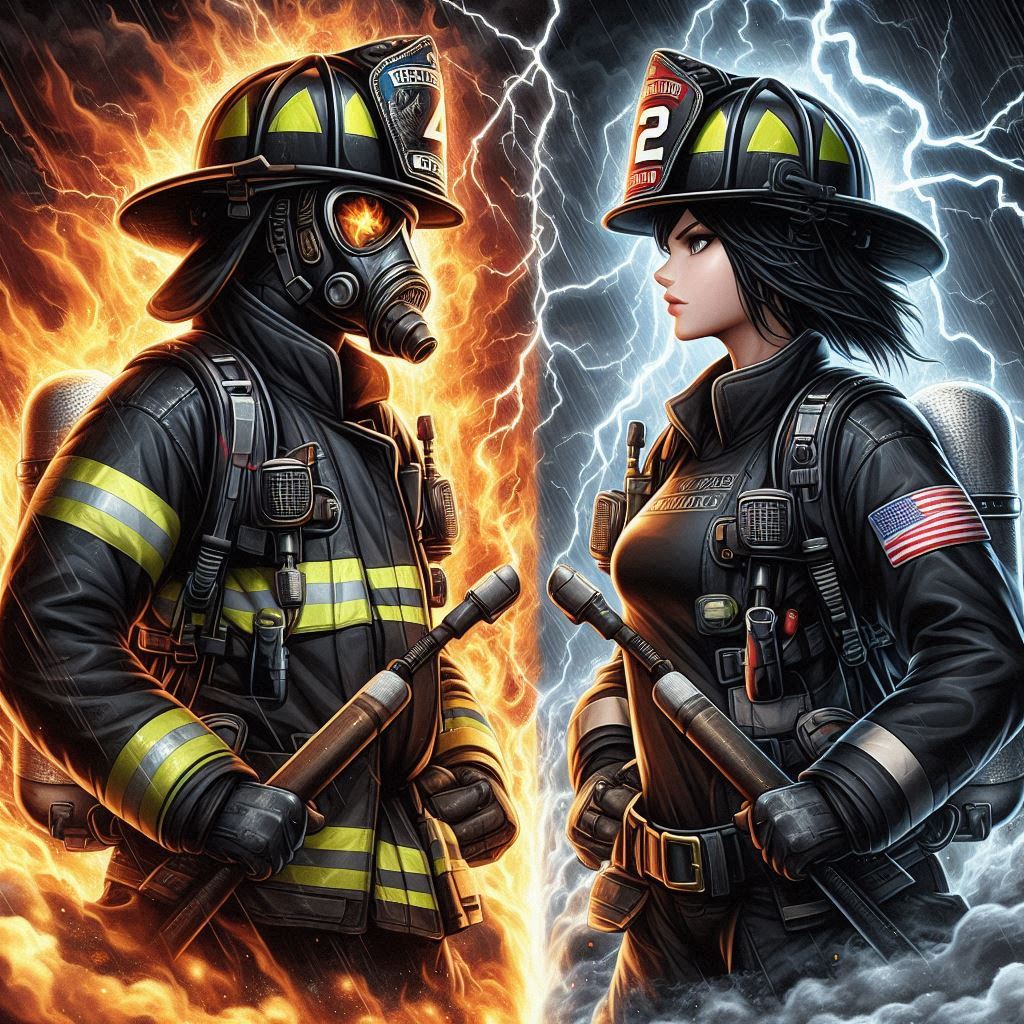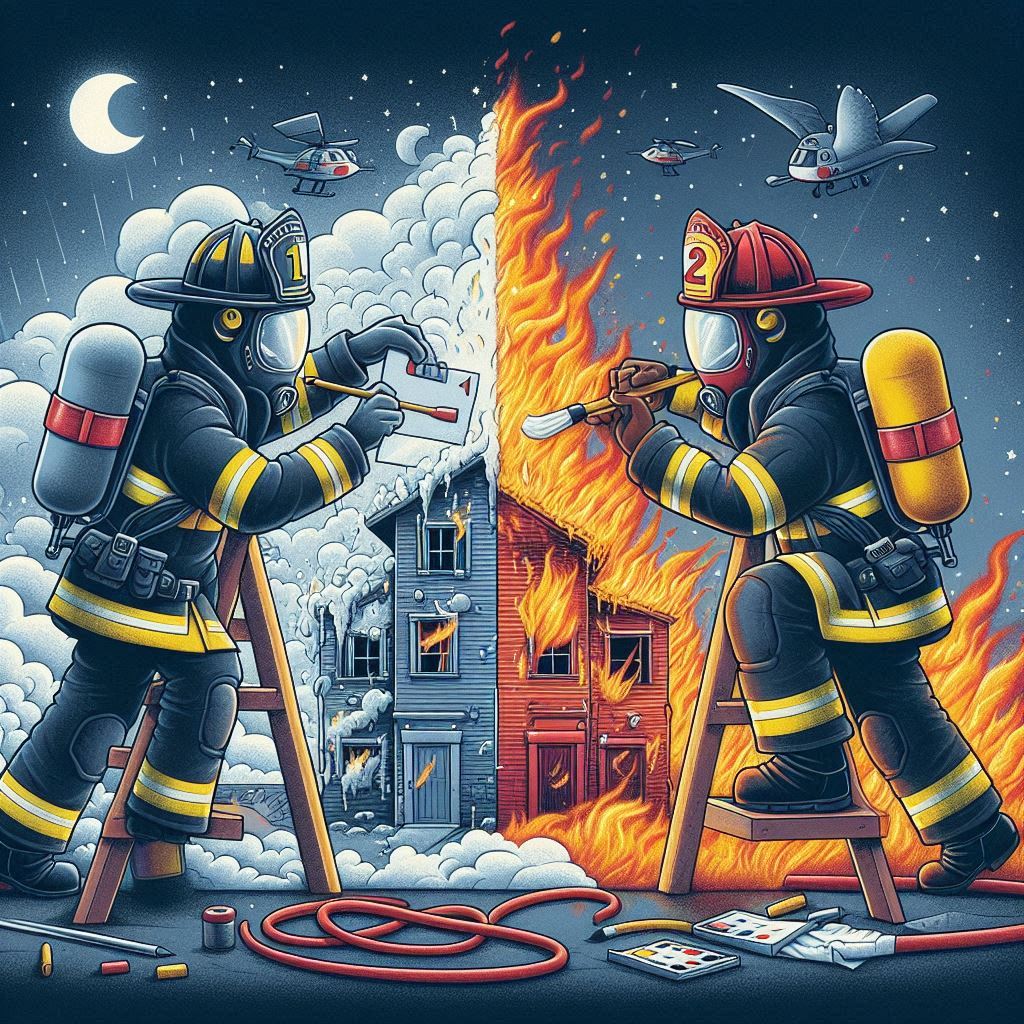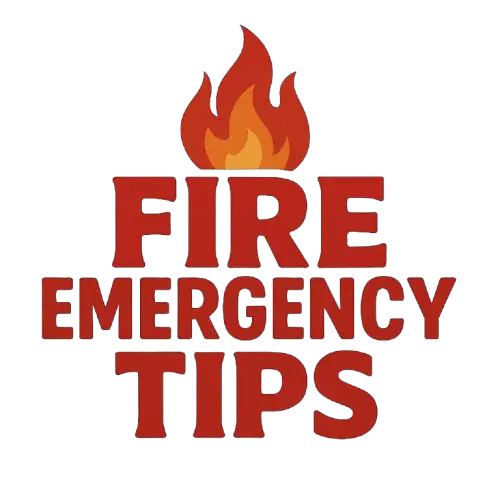
As a seasoned firefighter, I often get asked about the distinction between Firefighter 1 and Firefighter 2 certifications. Understanding the nuances between these levels is crucial for anyone looking to pursue a career in firefighting.
Firefighter 1 lays the foundation with essential skills like fire behavior, equipment handling, and rescue techniques. On the other hand, Firefighter 2 delves deeper into advanced topics such as hazardous materials response, incident command systems, and building construction.
In this article, I’ll break down the key disparities between Firefighter 1 and 2 certifications, helping you navigate your firefighting career path with confidence and clarity.
Key Takeaways
- Firefighter 1 focuses on fundamental firefighting skills, equipment handling, and basic first aid to lay a solid foundation for entry-level roles.
- Firefighter 1 training covers fire behavior, equipment handling, fire extinguishment techniques, and building construction basics.
- Mastering Firefighter 1 equips individuals with essential skills like understanding fire dynamics, using personal protective equipment, and basic first aid.
- Transitioning to Firefighter 2 offers advanced training in hazardous materials response, technical rescue, leadership, and decision-making in complex firefighting scenarios.
- Firefighter 2 certification prepares individuals for leadership roles, advanced firefighting tactics, and handling a wide range of emergencies with proficiency.
- Choosing between Firefighter 1 and Firefighter 2 certifications depends on career goals, with Firefighter 2 offering opportunities for career advancement and specialized firefighting roles.
Overview of Firefighter 1 Certification
When pursuing Firefighter 1 certification, individuals will delve into the foundational aspects of firefighting. This level equips me with essential skills needed to respond to emergency situations effectively. Firefighter 1 certification covers a wide range of topics, including fire behavior, equipment handling, and basic first aid. Here are some key points to note about the Firefighter 1 certification:
- Focus: Primarily focuses on fundamental skills and knowledge required for firefighting.
- Training: Involves hands-on training sessions to simulate real-life emergency scenarios.
- Curriculum: Covers fire extinguishment techniques, search and rescue operations, and basic emergency medical care.
- Prerequisites: Typically requires completion of basic firefighting courses and physical fitness assessments.
Completing Firefighter 1 certification sets a solid foundation for individuals aiming to advance their firefighting career. It lays the groundwork for mastering crucial skills that are essential in emergency response situations.

Curriculum for Firefighter 1
When embarking on the journey to become a firefighter, understanding the Curriculum for Firefighter 1 is essential. This foundational training program equips individuals with the necessary skills and knowledge to respond effectively to emergency situations. Here are some key components typically covered in the Firefighter 1 curriculum:
- Fire Behavior: Learning about the science of how fires start, spread, and develop is crucial for firefighters. Understanding different types of fires and how they behave is fundamental in formulating effective strategies to combat them.
- Personal Protective Equipment (PPE): Properly donning and using PPE is paramount for firefighter safety. Training in the correct use of gear such as turnout coats, helmets, gloves, and self-contained breathing apparatus (SCBAs) is a central aspect of Firefighter 1 training.
- Basic First Aid: Responding to medical emergencies is often part of a firefighter’s role. Firefighter 1 training includes instruction on basic first aid techniques, such as CPR, wound care, and assisting individuals in distress until professional medical help arrives.
- Fire Suppression Techniques: Firefighter 1 candidates learn various fire suppression methods, including the use of fire extinguishers, hose operations, and strategies for controlling and extinguishing fires in different scenarios.
- Building Construction: Understanding the different types of building structures and how they can influence firefighting operations is crucial. Firefighter 1 training often includes lessons on building construction materials, collapse dangers, and how to safely navigate structures during emergencies.
By mastering these essential components, individuals completing Firefighter 1 training establish a solid foundation in firefighting skills, setting the stage for further advancement in their careers.
Importance of Firefighter 1 in Building Skills
Firefighter 1 training plays a crucial role in developing foundational skills necessary for a successful firefighting career. During this training phase, individuals acquire essential knowledge and hands-on experience that form the basis of their expertise in emergency response situations. Here are key reasons why mastering Firefighter 1 is fundamental:
- Understanding Fire Behavior: Firefighter 1 training provides in-depth knowledge of fire dynamics and behavior, allowing me to anticipate how a fire will spread and react accordingly.
- Personal Protective Equipment (PPE): Learning to properly don and doff PPE is a critical aspect of Firefighter 1. It ensures my safety while operating in hazardous environments.
- Basic First Aid Skills: Gaining proficiency in basic first aid equips me with the ability to provide immediate care to individuals injured during emergencies.
- Fire Suppression Techniques: Firefighter 1 training covers a range of fire suppression methods that are essential for effectively combating different types of fires.
- Building Construction: Understanding the design and materials used in buildings is vital for developing strategies to navigate and operate within structures during emergencies.
Mastering these elements in Firefighter 1 training provides a solid foundation for further growth and specialization in firefighting.
Overview of Firefighter 2 Certification
When it comes to advancing in the firefighting field, Firefighter 2 certification plays a crucial role in building upon the foundational skills acquired in Firefighter 1 training. This certification signifies a higher level of proficiency and expertise, equipping individuals with the necessary knowledge and abilities to handle more complex situations and challenges effectively.
Firefighter 2 training delves deeper into various aspects of firefighting, encompassing advanced topics such as hazardous materials awareness, technical rescue, vehicle extrication, and incident command systems. This comprehensive training broadens one’s skill set and prepares them to handle a wider range of emergencies with confidence and competence.
One of the key differences between Firefighter 1 and Firefighter 2 certification is the scope of responsibilities that individuals are trained to undertake. While Firefighter 1 focuses on foundational skills and basic firefighting techniques, Firefighter 2 certification expands on these fundamentals, emphasizing leadership, decision-making, and advanced firefighting tactics.
Achieving Firefighter 2 certification is a significant milestone in a firefighter’s career journey, opening up opportunities for career advancement, specialization in specific areas of firefighting, and potential leadership roles within the fire service. It serves as a testament to one’s dedication to continuous learning and improvement in the field of firefighting.
Firefighter 2 certification requires dedication, perseverance, and a commitment to honing skills to the highest level of proficiency. By completing this advanced training, firefighters demonstrate their readiness to take on greater challenges and responsibilities, contributing to the safety and well-being of their communities with expertise and professionalism.
Curriculum for Firefighter 2
When it comes to the Curriculum for Firefighter 2, the training delves into more advanced and specialized areas compared to Firefighter 1. This stage focuses on honing the skills acquired in Firefighter 1 and expanding knowledge to handle complex emergency situations effectively.
In Firefighter 2 training, subjects covered include:
- Hazardous materials awareness
- Technical rescue
- Incident command systems
- Leadership and decision-making in firefighting scenarios
- Advanced firefighting tactics
Additionally, Firefighter 2 certification requires individuals to demonstrate proficiency in areas such as emergency medical procedures and equipment maintenance, preparing them to tackle a wide range of challenges in the field.
Structured to build upon the foundation laid in Firefighter 1, the Firefighter 2 curriculum equips firefighters with the knowledge and skills needed to excel in high-pressure situations and take on leadership roles within the firefighting community.
Advancing Skills with Firefighter 2
Transitioning from Firefighter 1 to Firefighter 2 training is a significant step towards enhancing expertise and capabilities in the firefighting realm. With Firefighter 2 certification, focused areas of study deepen, ensuring a more comprehensive skill set to handle complex emergency situations with precision and efficiency. Let’s delve into how Firefighter 2 training propels firefighters to the next level of proficiency:
- Specialized Knowledge: Firefighter 2 coursework delves into advanced topics like fire behavior, building construction, and incident management, granting firefighters in-depth understanding crucial for effective response strategies.
- Technical Proficiency: Mastery of specialized tools and equipment is a cornerstone of Firefighter 2 training, equipping individuals with the precision needed to tackle diverse firefighting scenarios.
- Leadership Development: Firefighter 2 curriculum emphasizes leadership skills, honing the ability to command and coordinate teams during emergencies with confidence and clarity.
- Critical Decision-Making: Training in Firefighter 2 hones quick thinking and decision-making under pressure, preparing firefighters to assess risks and execute strategies swiftly and effectively.
Moving beyond foundational training, Firefighter 2 certification is the crucial bridge to advanced expertise in the firefighting domain, shaping individuals into competent and proficient firefighters ready to tackle the dynamic challenges of the field.
Firefighter 1 vs Firefighter 2 certification table
Firefighter certifications are typically based on the National Fire Protection Association (NFPA) standards, primarily NFPA 1001, “Standard for Fire Fighter Professional Qualifications.”1 Firefighter I and Firefighter II represent progressive levels of expertise and responsibility.2
Here’s a comparison table outlining the key differences:
| Feature/Aspect | Firefighter I (FFI) | Firefighter II (FFII) |
| Primary Role | Entry-level firefighter; functions as an integral member of a firefighting team under direct supervision in hazardous conditions. Focuses on basic fire suppression and related tasks. | Advanced-level firefighter; possesses the skills and depth of knowledge to function under general supervision. Takes on more responsibility, including coordinating actions, making decisions, and potentially leading smaller operations. |
| Prerequisites | – High school diploma or GED – Minimum age (typically 18) – Hazardous Materials Awareness Training or Certification (NFPA 1072 Awareness Level) – CPR and Emergency Medical Services Training (or current EMS certification) – Interior structural fire attack demonstration | – Firefighter I Certification (NFPA 1001 FFI) – Hazardous Materials Operations Training or Certification (NFPA 1072 Operations Level) – Incident Command System (ICS) course (e.g., NIMS 100 & 700) – Vehicle Rescue Operations course/certification – Demonstrated ability to complete incident reports (e.g., using NFIRS format) – Demonstrated understanding of fire prevention, preparedness, and maintenance (e.g., conducting residential fire safety surveys). |
| Key Skills & Knowledge | – Donning and doffing personal protective equipment (PPE), including SCBA – Safe use of ground ladders, hoses, nozzles, and fittings – Basic fire behavior and suppression principles (fire triangle, tetrahedron) – Forcible entry techniques – Search and rescue operations (basic) – Ventilation techniques (basic) – Salvage and overhaul – Fireground communications – Basic first aid and emergency medical response – Understanding of fire apparatus and basic vehicle operation. | – Advanced fire control techniques, including foam systems for liquid fuel fires – Advanced ventilation strategies – In-depth understanding of fire prevention and public education – More complex rescue operations (e.g., rope rescue, auto extrication) – Knowledge of fire alarm, detection, and automatic suppression systems – Incident scene operations and tactical decision-making – Fire origin and cause determination (basic understanding for reporting) – Maintenance and testing responsibilities for equipment – Community risk reduction principles – Use of advanced equipment like thermal imaging cameras (TICs). |
| Supervision Level | Direct supervision | General supervision; often expected to make initial tactical decisions and lead small teams. |
| Scope of Operations | Primarily focuses on executing tasks as part of a team under direct command. Limited decision-making authority in complex or evolving incidents. | Expanded scope, including taking a more active role in strategic and tactical decisions, coordinating resources, and leading specific operations on the fireground. Often required for career firefighters and advancement. |
| Training Hours | Varies by jurisdiction, but typically ranges from 180-240 hours. | Builds upon Firefighter I; typically requires an additional 100-200+ hours of training beyond FFI. |
| Typical Career Path | Often the minimum certification for volunteer firefighters or entry-level paid positions, usually requiring working directly under the supervision of a Firefighter II or higher. | Generally a prerequisite for career progression, allowing firefighters to take on more senior roles, become officers, or specialize in areas like fire investigation or public education. |
It’s important to note that specific requirements and course content can vary slightly by state, municipality, or even training academy, but they generally adhere to the NFPA 1001 standard.
Key Differences Between Firefighter 1 and Firefighter 2
Transitioning from Firefighter 1 to Firefighter 2 signifies a significant leap in expertise and capabilities within the firefighting realm. The focus shifts from basic skills to more advanced and specialized knowledge, preparing individuals to tackle complex emergency situations with enhanced proficiency. Let’s delve into the key disparities between Firefighter 1 and Firefighter 2 certifications:
- Scope of Training:
- Firefighter 1 training primarily covers fundamental firefighting skills, rescue techniques, and equipment operation.
- Firefighter 2 certification delves deeper into areas such as fire behavior, building construction, incident command systems, and hazardous materials handling.
- Responsibilities:
- Firefighter 1 focuses on assisting senior team members, carrying out tasks under supervision, and ensuring basic safety protocols.
- Firefighter 2 holders are equipped to take on more leadership roles, make critical decisions independently, and lead teams during complex firefighting operations.
- Focus on Specialization:
- Firefighter 1 provides a broad overview of firefighting concepts and practices to establish a solid foundation.
- Firefighter 2 emphasizes specialized training in advanced firefighting tactics, technical rescue operations, and emergency response coordination.
- Skill Development:
- Firefighter 1 training aims to build core competencies, physical fitness, and teamwork skills crucial for entry-level firefighting roles.
- Firefighter 2 certification enhances technical proficiency, critical thinking abilities, and strategic decision-making skills essential for managing intricate fire incidents effectively.
The progression from Firefighter 1 to Firefighter 2 reflects the evolution of expertise, leadership, and proficiency required to handle diverse firefighting challenges with confidence and precision.
Choosing the Right Certification for Your Career Path
When deciding between Firefighter 1 and Firefighter 2 certifications, it’s essential to consider your career goals and aspirations. Here are some key points to help guide your decision:
- Firefighter 1: Perfect for those starting in the firefighting industry, this certification provides fundamental knowledge and skills to handle basic firefighting tasks efficiently.
- Firefighter 2: If you’re looking to advance your career and take on more challenging roles, Firefighter 2 is the next logical step. This certification equips you with specialized expertise to lead teams and manage complex fire incidents with confidence.
Keep in mind that obtaining a Firefighter 2 certification opens up opportunities for leadership roles and specialized firefighting positions. It demonstrates your commitment to professional development and enhances your credibility within the firefighting community.
When choosing between Firefighter 1 and Firefighter 2 certifications, evaluate your career goals, current skill level, and willingness to take on more responsibility. Selecting the certification that aligns with your ambitions can set you on the right path for a successful firefighting career.
Conclusion
Choosing between Firefighter 1 and Firefighter 2 certifications is pivotal in shaping a successful firefighting career. Firefighter 1 lays the groundwork with essential skills, while Firefighter 2 propels you towards leadership roles and specialized positions. Your certification choice should align with your career goals and readiness for increased responsibilities. It’s not just about the certification; it’s about the path you pave for your firefighting journey. Make an informed decision based on your ambitions and aspirations to set yourself up for a fulfilling and impactful career in the firefighting community.
Frequently Asked Questions
What is the difference between Firefighter 1 and Firefighter 2 certifications?
Firefighter 1 focuses on fundamental skills for beginners, while Firefighter 2 offers specialized knowledge for leading teams in complex fire incidents.
Why should I consider obtaining a Firefighter 2 certification?
Obtaining a Firefighter 2 certification opens doors to leadership roles and specialized positions, showcasing professional commitment and credibility in the firefighting community.
How should I choose between Firefighter 1 and Firefighter 2 certifications?
Align your certification choice with your career ambitions, skill level, and readiness for increased responsibility to pave the way for a successful firefighting career.
